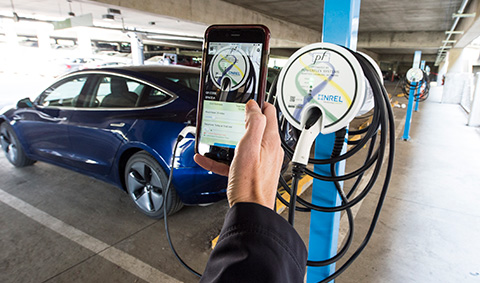Electric Vehicle Smart-Charge Management and Flexibility Analysis
NLR researchers investigate smart-charge management strategies to reduce consumer charging costs and utility expenses for capacity expansion to reliably and affordably support growing grid demands, such as electric vehicle (EV) charging.

Integrated EV smart charging—accomplished via smart-charge management strategies—can reduce costs and improves grid reliability by reducing peak electricity demand, more effectively integrating all energy sources, and supporting grid-responsive charging. Effective smart charging seamlessly meets the needs of EV drivers and the grid.
Researchers use smart-charge management controls to better understand the energy and power requirements of EV charging and to identify potential flexibility in those needs that could support shifts in energy demand during longer vehicle dwell periods. Developing controls that leverage this flexibility will be critical to ensuring a reliable, affordable, and resilient energy system.
Identification of Electric Vehicle Adoption and Loads
To support utilities and other industry partners in preparing for increased electric loads from vehicles, data centers, and other energy users, NLR researchers conduct analyses of current grid loads as well as any other potential future scenarios. Researchers base estimates on future projections and current travel patterns across a range of vehicle classes and transportation systems. Identifying and de-risking technology solutions supports the nation's energy providers in planning for future loads and impacts.
To estimate these loads, NLR uses these tools:
EVI-EnSite: Electric Vehicle Infrastructure – Energy Estimation and Site Optimization Tool
Can simulate any combination of EV charging infrastructure configurations—including light-, medium-, and heavy-duty EV charging with various station setups—and optimize their operations.
EDGES: Enabling Distributed Generation Energy Storage Model
Configures optimal, cost-effective behind-the-meter-storage and distributed generation systems based on the climate, building type, and utility rate structure of potential EV charging sites.
For more resources to conduct EV infrastructure analysis, see the full EVI-X Modeling Suite.
Smart-Charging Strategies
NLR researchers are demonstrating the value of smart-charge management to increase flexible and efficient grid operations, all while supporting reliability. By employing EV smart-charging strategies, the electricity needs required for charging are distributed across different times throughout the day, which could simultaneously save ratepayers money and prevent the power grid from overloading.
Distributed Energy Resources Integration
Integration with distributed energy resources coordinates EV charging with electricity generated from all energy sources.
Communication and Coordination
Communication and coordination among EVs, charging infrastructure, and the power grid help optimize charging times and reduce peak demand across homes, buildings, and distribution feeders.
Nonwire Solutions Management
The management of increased electricity demand without additional investment in traditional power grid infrastructure is known as "nonwire" solutions.
Charging Load Estimation
Estimation of regional charging loads distributes charging more evenly across the grid, thereby reducing peak generation needs, and ensuring safe and reliable access to energy for all ratepayers.
Control Adjustment
Adjustment of controls maintains grid reliability during extreme weather events.
Grid Impacts Modeling
NLR researchers are studying the impacts of EV charging on the power grid under various managed charging scenarios using real-world feeder data and state-of-the-art simulations.
To understand these impacts, NLR partners with electric utility companies to share information on distribution feeders and run power flow analysis using tools such as OpenDSS, a distribution system simulator. Researchers also leverage tools such as NLR's Distribution Transformation Tool (on GitHub) to accelerate the conversion of utility feeder models to OpenDSS and characterize existing assets such as lines, transformers, loads, and control devices.
Hosting capacity analysis is performed using NLR's Distribution Integration Solution Cost Options Tool (on GitHub) tool to assess the existing capabilities of distribution feeders and determine how much additional load the grid can support.
For coordinating all EV and grid analysis, researchers use HELICS (Hierarchical Engine for Large-Scale Infrastructure Co-Simulation) to simulate the future of EV charging, potential resulting impacts on the grid, and effectiveness of smart-charging management to mitigate these impacts by shifting charge sessions.
This analysis can help transportation stakeholders:
- Optimize construction plans to meet EV drivers' needs
- Select managed charging methods to ensure balanced distribution of services and keep costs low
- Use additional modeling and scenario simulations to aid in decision-making for grid investments
- Construct and validate various residential transformer, secondary service, and EV charger combinations to measure EV charging impacts
- Perform grid analyses on public service feeders.
Contact
Share
Last Updated Dec. 6, 2025
